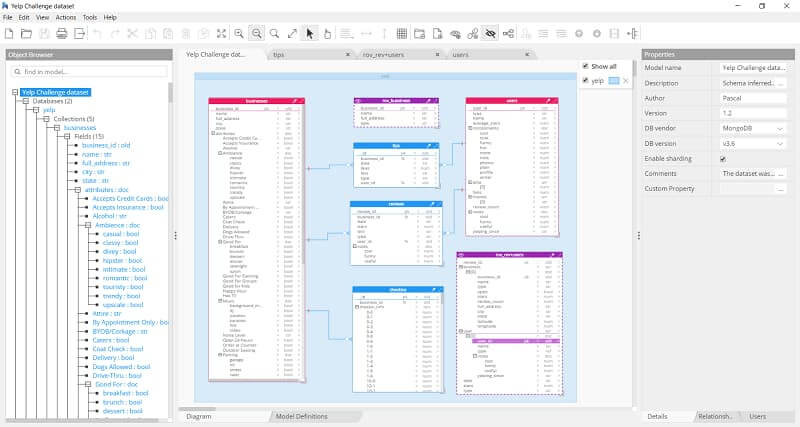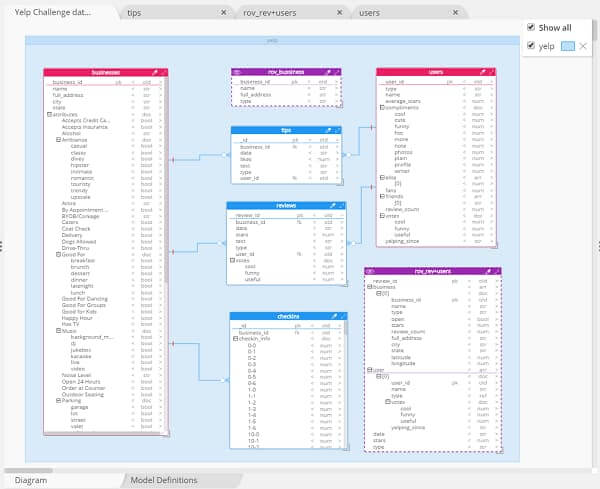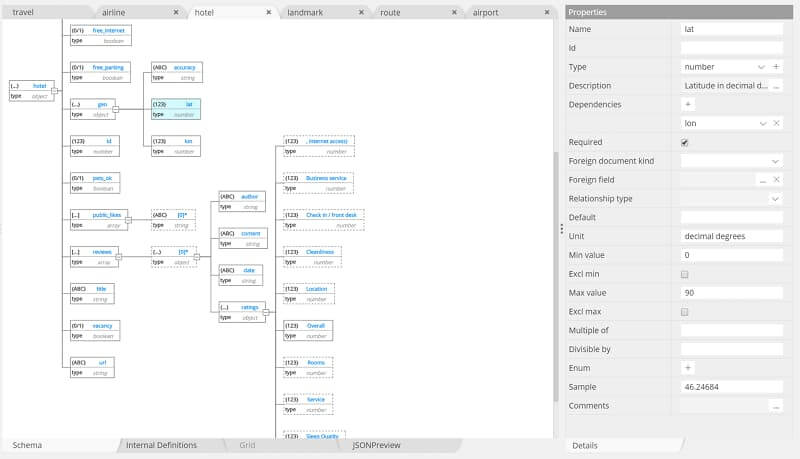MongoDB Data Modeling and Schema Design
MongoDB provides the possibility to store data with a flexible and dynamic schema. This is an advantage over SQL relational databases where you must define and declare the structure of the data prior to inserting it in the database, and where it becomes hard to modify that structure afterwards. MongoDB stores data in documents, and collections of documents do not enforce the structure of the documents, even if these documents have a similar structure.
The challenge in MongoDB data modeling is to balance such flexibility with the needs of an application to access data with predictable patterns. The buzz around the “schemaless” and “non-relational” nature of NoSQL has promoted the illusion of a magical solution. But the reality is that it is harder to design an application with no structure, no schema, and no relationships. This is where Hackolade Studio provides critical added value with its visual schema design and MongoDB schema generation capabilities.
Try Hackolade Studio for FREE
There's no risk, no obligation, and no credit card required!
Just access the application in your browser.
No credit card. No registration. No download. Runs in browser. No cookies. Local storage of models. Security first.
MongoDB Data Modeling Tool
Hackolade pioneered the field of data modeling for NoSQL databases when it developed a visual tool to perform the schema design of JSON structures. Written as a visual editor for JSON Schema, Hackolade Studio is built from the ground-up to leverage the flexibility of JSON nested objects and polymorphism.

Hackolade Studio is a MongoDB schema design software that dynamically generates scripts as you visually build a data model in a forward-engineering use case. It also derives MongoDB schemas based on the reverse-engineering of existing instances, so a data modeler or information architect can enrich the model with descriptions, properties, and constraints.
Schema Visualization
The visualization tool also generates HTML documentation of the database schema which serves as a platform for dialog between analysts, designers, architects, developers, and DBAs. The MongoDB Schema Design tool supports several use cases to help enterprises manage their databases

Testimonial
According to Alan Chhabra, VP of Worldwide Partners at MongoDB: "We’ve seen time and again how Hackolade can improve application quality and time to market for developers. It gives teams more control over their data by providing powerful data modeling, cataloging, and documentation capabilities." Hackolade is used by many additional references.
Components of a MongoDB Data Model
The simplest way to visualize a schema is to present it in an Entity-Relationship Diagram, a sort of blueprint of the foundations of an application, showing a map of the data. The future queries and data representation in the application screens are the main drivers for the design of a data model.

Entity Relationship Diagram (ERD)
An ER diagram displays JSON object nesting and illustrates the embedding and denormalization necessary for the scale and performance of the application. MongoDB is a non-relational NoSQL database technology, since relationships are not enforced by the database engine. However, data itself contains relationships, and an ER Diagram provides a visualization of these relationships.
Hierarchical View of Nested Objects
A data model is described with definitions of properties and constraints for each collection and field. This can be supplemented with detailed descriptions and a log of team comments gathered as the model adapts over time for the schema evolution.

Data Governance for Unstructured and Semi-Structured Data
With complex application developed by large teams, it becomes a challenge to insure consistent ways to store data. To leverage the recent introduction of the validator with support for JSON Schema, the data model is the ideal place to store the business rules and constraints to limit inconsistencies and inaccuracies in the data, so this validator can enforce them thanks to a script generator.

Outputs of a Data Modeling Tool for MongoDB
In addition to the script creation to facilitate development, the HTML documentation provides a rich, human-readable report that includes diagrams, collections, relationships and all their metadata. Many additional features have been developed to help data modelers.
Interactions with MongoDB instances
Hackolade Studio works seamlessly with MongoDB instances installed locally, self-hosted on-premises or in the cloud, or of course MongoDB Atlas.
Forward-engineering
Out of the box, MongoDB is a schemaless database. But it also includes many ways to ensure data quality, consistency, and governance. With Hackolade Studio, it is easy to leverage MongoDB's schema validation capabilities. The tool automatically generates the $jsonschema validation script and allows you to apply it directly to the instance if you have the proper rights, or export the script so it can be applied by a DBA after review.
You may also build indexes with the handy assistance of forms pre-configured to support all the indexing capabilities of MongoDB, then automatically generate the script without requiring knowledge of the necessary syntax.
Hackolade Studio also provides assistance in handling In-Use Encryption, also known as Client-Side Field-Level Encryption, a connection method allowing you to encrypt a subset of fields in your collections.
Hackolade Studio allows you to generate fake but realistic data for your data models. Using synthetic data can be useful during system development, testing, and demos. The real benefit comes when you can generate large, if not massive, amounts of test data, for general testing, as well as performance, and even load testing. And insert this data directly into your MongoDB instance from Hackolade Studio.
Reverse-engineering
The schemaless nature of MongoDB provides much flexibility. But it may scare off some decision makers in large organization, who might fear some loss of governance. With its advanced schema inference algorithms, Hackolade Studio discovers, documents, represents polymorphic structures in MongoDB collections, and makes them available for business-facing data catalogs to promote a shared understanding of the meaning and context of data stored in MongoDB.
Benefits of Data Modeling
Businesses make decisions based on information stored in databases. With data being a valuable corporate asset, data modeling becomes critical to understanding data, its interrelationships, and its rules. Hackolade increases data agility by making its structure transparent and facilitating its evolution. The benefits of data modeling for MongoDB are widespread and measurable.
NoSQL schema design is a best practice to ensure that applications evolve, scale, and perform well. A good data model helps reduce development time, increase application quality, and lower execution risks across the enterprise.
Free trial
To experience the first MongoDB data modeling tool and try the full experience of Hackolade Studio free for 14 days, download the latest version of Hackolade Studio and install it on your desktop. There's no risk, no obligation, and no credit card required! The software runs on Windows, Mac, and Linux, plus it supports several other leading NoSQL databases. Or you can run the Community edition in the browser.
Try Hackolade Studio for FREE
There's no risk, no obligation, and no credit card required!
Just access the application in your browser.
No credit card. No registration. No download. Runs in browser. No cookies. Local storage of models. Security first.